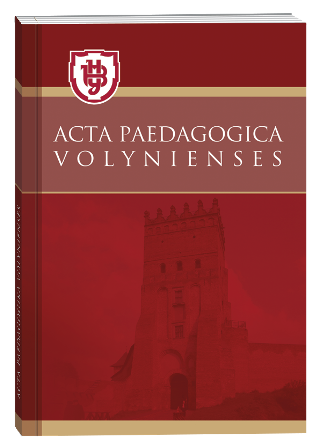КОНСТРУЮВАННЯ З ПУХНАСТОГО ДРОТУ В ЗАКЛАДІ ДОШКІЛЬНОЇ ОСВІТИ
DOI:
https://doi.org/10.32782/apv/2021.5.6Ключові слова:
діти дошкільного віку, конструювання, пухнастий дріт, художньо-творча діяльність, художня працяАнотація
У статті проаналізовано наукові праці українських учених, які займалися питаннями художнього конструювання. З’ясовано, що продуктивні види діяльності особливо цікаві дітям дошкільного віку, оскільки викликають у них жвавий інтерес, дозволяють виявляти самостійність, застосовувати власний, попередньо набутий досвід. Дослідження В. Журенко, Л. Зайцевої обґрунтовують розвивальні можливості конструювання для інтелектуального розвитку дітей дошкільного віку, доводять цінність накопичених дітьми уявлень про довкілля, розвиток ручних умінь і навичок у процесі конструктивної діяльності. Конструктивна діяльність сприяє формуванню стійких пізнавальних інтересів, розвитку творчої активності. В умовах закладу дошкільної освіти педагоги, супроводжуючи конструювання вихованців, використовують різноманітні форми, методи, засоби освітньої діяльності. Особливістю конструктивної діяльності в закладі дошкільної освіти вважаємо можливість використання різних матеріалів під час спеціально організованих форм освітньої взаємодії та самостійної художньої діяльності. У публікації висвітлено типові недоліки організації художньої праці в закладі дошкільної освіти. Подано різні види завдань з конструювання, розглянуто рівні їх складності. Представлено традиційні матеріали та види завдань з конструювання для дітей дошкільного віку. З’ясовано, що з появою нових цікавих матеріалів для творчості значно розширився зміст художнього конструювання. На основі вивчення методичної та довідкової літератури визначено поняття «синельний (пухнастий) дріт», подано його художні характеристики. Запропоновано основні прийоми роботи з декоративним дротом, доступні дітям дошкільного віку. Розглянуто особливості конструювання із синельного дроту з дітьми дошкільного віку. Акцентовано увагу на рекомендаціях з техніки безпеки.
Посилання
Базовий компонент дошкільної освіти (Державний стандарт дошкільної освіти) нова редакція. URL: https://mon.gov.ua/storage/app/media/rizne/2021/12.01/Pro_novu_redaktsiyu%20Bazovoho%20komponenta%20doshkilnoyi%20osvity.pdf (дата звернення: 22.10.2021).
Біла І.М. Динаміка розвитку творчого конструювання у дошкільному віці. Актуальні проблеми психології : зб. наук. праць Інституту психології ім. Г.С. Костюка НАПН України. Київ : Видавництво «Фенікс», 2012. Т. ХІІ: Психологія творчості. Вип. 14. С. 26–37.
Біла І.М. Психологія дитячої творчості. Київ : Фенікс, 2014. URL: https://core.ac.uk/download/pdf/32309053.pdf (дата звернення: 22.10.2021).
Журенко Л. Творче конструювання як засіб інтелектуального розвитку дітей старшого дошкільного віку. URL: http://www.rusnauka.com/25_SSN_2009/Pedagogica/51493.doc.htm (дата звернення: 22.10.2021).
Зайцева Л.І. Вивчення особливостей процесу організації ознайомлення дітей дошкільного віку з об’єктами довкілля. Збірник наукових праць Бердянського державного педагогічного університету. Педагогічні науки. 2013. № 3. С. 49–54.
Пісоцький О.П., Пісоцька Л.М. Характеристика продуктивних видів діяльності дітей старшого дошкільного віку. Психолого-педагогічні науки. 2018. № 3. С. 140–146. URL: http://lib.ndu.edu.ua/dspace/bitstream/123456789/939/1/24.pdf (дата звернення: 22.10.2021).
Попович О.М. До питання особливостей конструктивної діяльності дітей дошкільного віку. Науковий вісник Ужгородського національного університету. Серія: Педагогіка. Соціальна робота. Ужгород, 2014. № 32. С. 156–158.
Сазонова А. Саприкіна О. Організація конструювання з дошкільниками. Вихователь-методист дошкільного закладу. 2015. № 5. С. 26–32.
Федорович А., Савченко Л. Конструювання як засіб розвитку мислення дітей дошкільного віку. URL: http://mir.dspu.edu.ua/article/view/216688/216713 (дата звернення: 22.10.2021).







